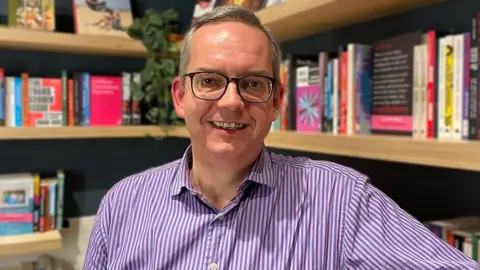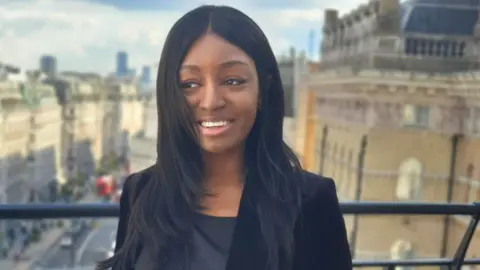Bisexuality more visible but 'work to do' on safety
 Julia Shaw
Julia ShawMore people identify as bisexual than gay or lesbian, a new study suggests.
The poll says bisexuality is the next-most-common identity after being heterosexual.
Survey respondents from Generation Z - those aged 16 to 26 - are least likely to identify as straight.
LGBT charity, Stonewall, which commissioned the study, said the findings told a "positive story" but said more needed to be done to help bisexual people feel safe.
The study asked 16 to 75-year-olds questions about their gender identity, sexual orientation and attraction.
Three polls were carried out through the market researcher, Ipsos Mori, in June, which is Pride Month, and August 2022, each with a representative sample of about 2,000 people across England, Wales and Scotland.
When asked which label they identify as, 84% of all respondents said they are straight, compared with 5% bisexual, and 4% gay or lesbian.
The answers varied depending on people's age. Some 10% of Gen Z respondents said they were bisexual compared with 2% of baby boomers (those aged 56 to 75).
'It's not being half gay, half straight'
Dr Julia Shaw, a psychologist and author of the book, Bi: The Hidden Culture, History and Science of Bisexuality, says it can be "frustrating" that many people do not know what being bisexual means.
"It can make you fall into situations where you experience biphobia and negative comments about 'oh, what does that mean? You're promiscuous? Or you can't be monogamous?'" she says.
"Bisexuality is a real identity, it's not being half gay, half straight."
She says trends over the past decade all point towards bisexual people being the largest "sexual minority" but that many people are not aware of how widespread bisexuality is.
Fewer people surveyed by Stonewall said they had met someone who is bisexual than someone who is gay or lesbian.
Although the findings show that younger groups seem to be more open to same-sex attraction, the apparent shift in attitudes may also be giving other generations more confidence.
John, 49, came out as bisexual just last year.
The father-of-three said he'd known for a long time but thought of it as "being straight with fuzzy edges" and was "suppressing" how he really felt.

He said his family were supportive when he eventually told them.
"It was obviously a bit difficult at first, like a shock, but it wasn't about me wanting to change my behaviour, it was being authentically who I am.
"My children weren't fazed by it and I think that's a generational thing."

When asked about which sex they are attracted to, without labels like "straight", "gay" or "bi", just 66% of people in the study said they were only attracted to people of the opposite sex.
Stonewall's chief executive, Nancy Kelley, said the findings tell a "really positive story about the nation we are becoming".
"It tells us that lesbian, gay, bi, trans and queer people are more visible and more connected than we've ever been," she added.
"When you take the label away altogether you get an even bigger community of people saying 'do you know what, I can be attracted to different kinds of people'."
She said it was "really welcome" that bi people were becoming "much more visible" but said biphobia was still "really common".
"We've got a lot of work to do to make sure that bi people feel safe, sharing who they are with us and being out in their day-to-day lives."
The results, published by Stonewall on Thursday, indicate a similar trend to UK official statistics, with a slow decline of people identifying as heterosexual. The official statistics on bisexuality could not be directly compared as the questions are worded differently.
Another finding of the study was that 2% of respondents said they are asexual, meaning they experience little or no sexual attraction towards anyone.
Yasmin Benoit has identified as asexual since she was 15.
The 26-year-old said one of the "most common misconceptions" she's seen is that people think asexual people must have "something physically or mentally wrong, like it must be a personality flaw, or a hormone deficiency or a mental disorder".
But she says being asexual means she can "just focus on all the other joys of life" instead of worrying about "navigating sexual situations".
"It definitely doesn't limit me in any way."

In terms of gender identity, fewer than 3% who took part identified as transgender or as non-binary.
The most recent government figures estimate there are 200,000-500,000 transgender people in the UK.
The results of the 2021 Census for England and Wales are expected to give a more detailed picture of the make up of the population when released later this year.
